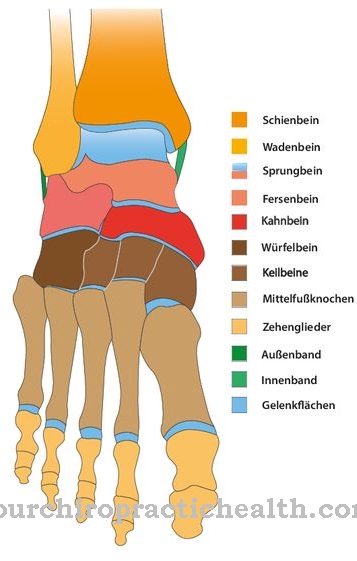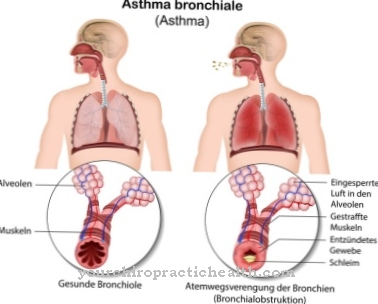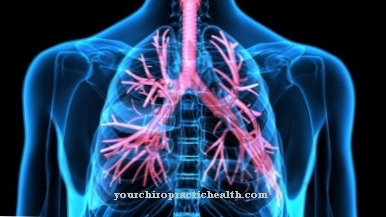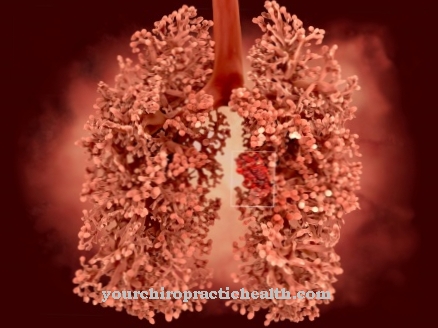Osteomalacia is a painful softening of the bones. It is mostly caused by a lack of vitamin D or calcium.
What is osteomalacia?

© Yulia Furman - stock.adobe.com
Osteomalacia refers to the softening of the bones in the human body, often caused by a lack of vitamin D. In children, these symptoms are also known as rickets.
Soft bones affected by osteomalacia are more likely to be injured or broken than harder, healthier bones. Osteomalacia should not be confused with osteoporosis, another disorder that can also lead to bone damage. Osteomalacia is caused by a defect in the bone formation process, while osteoporosis is a weakening of the bone structure that has already developed.
Muscle and bone pain are the most common signs and symptoms of osteomalacia. Treatment for osteomalacia involves correcting the prevalent deficiencies in calcium and vitamin D; as well as the targeted healing of any underlying disease associated with the development of osteomalacia.
causes
The human body uses calcium and phosphates to build strong bones. The disease Osteomalacia usually arises from an insufficient supply of these nutrients within the diet. Likewise when the body cannot process the substances sufficiently.
Vitamin D is made by the body when sunlight hits the skin. Vitamin D is needed to process calcium. Osteomalacia can occur in people who spend little or no time in sunlight, or who live in areas where there is short sunshine or the air is very polluted.
Osteomalacia can also result from certain operations on the stomach (gastrectomy). Because the absorption of vitamin D from food is so reduced. Celiac disease, liver or kidney damage can also lead to osteomalacia as they disrupt essential body processes.
Symptoms, ailments & signs
At the beginning, osteomalacia manifests itself through muscle weakness and unspecific bone and joint pain. In the further course the characteristic hump develops. The increasing curvature of the upper body is associated with chronic pain and restricted mobility. The visual changes can also cause mental complaints.
A hump once it has arisen can usually no longer be remedied, which is why the misalignment is a constant burden for those affected. As a result of the reduced bone density, there is also an increased susceptibility to fractures. The femoral neck and vertebrae are particularly affected. If the symptoms are due to malnutrition, symptoms such as weakness, tiredness and difficulty concentrating can arise.
In addition, those affected are often emaciated and have a sickly appearance. If the cause of the osteomalacia is treated early, the symptoms described will usually subside. Most patients are symptom-free within one to two months after the start of treatment. In the absence of treatment, the softening of the bones leads to further fractures and deformations.
In the long term, there is stiffness, chronic pain and finally bed rest. If left untreated, the disease takes a severe course, which is associated with further symptoms and complaints. External signs such as the hunchback described above also become stronger as the disease progresses.
Diagnosis & course
To the cause of the Osteomalacia and rule out possible other diseases, the patient may need to have the following tests performed. Blood and urine test: If the osteomalacia is caused by a lack of vitamin D or a loss of phosphate, these abnormal values can be detected in the blood or urine.
X-ray examination: Osteomalacia leads to characteristic injuries in the bone structures that can be seen on X-rays.
Bone biopsy: During a bone biopsy, the doctor inserts a thin needle through the skin into the bone. A small sample of the bone is taken and examined under a microscope. While the biopsy is very accurate in determining osteomalacia, it is rarely used.
Complications
Osteomalacia is a disease that can be prevented if the body is adequately supplied with vitamin D. In the case of an existing illness, serious complications can only be avoided with the help of intensive treatment. If left untreated, what is known as a creeping pathological fracture usually develops.
However, since the bones are softer here, the fractures do not occur suddenly, but rather gradually. They are thus expressed in increasing curvatures in places where there are increased bending loads. This leads to the curvature of the upper body. The femoral neck is also subject to special bending stresses, so that fractures of the upper neck can often occur in osteomalacia. This is particularly the case with older people, as they often suffer from severe deficiency in vitamin D, in addition to softening bones, as well as increased osteoporosis.
Femoral neck fractures usually cause severe pain for the patient and limit mobility. The healing process is usually very slow. The conservative treatment of a femoral neck fracture increases the risk of leg vein thrombosis and pulmonary embolism. Because of this, osteomalacia can also be more fatal in the elderly. This is precisely why it is important to ensure that older people have an adequate supply of vitamin D.
When should you go to the doctor?
A reduction in the general physical exercise capacity or restrictions in the range of motion should be presented to a doctor. If there are general problems with the musculoskeletal system or abnormal posture, a doctor's visit is advisable. A crooked posture is characteristic of those suffering from osteomalacia. In addition, those affected suffer from pain. You should generally refrain from taking pain reliever medication until you have consulted a doctor. There may be side effects that lead to further deterioration in health. Concentration disorders, fatigue or fatigue should be discussed with a doctor.
If the existing symptoms increase in scope or intensity, a doctor should be consulted immediately. A decrease in quality of life or a decrease in well-being should be clarified by a doctor. If the daily obligations or sporting activities can no longer be performed in the usual way, the person concerned needs help. Stiffening of the muscular system, internal weakness as well as exhaustion and fatigue are signs of a disease that requires treatment. If the irregularities persist for several days or weeks, a doctor is required.
If left untreated, serious health disorders and other visual changes in the bone structure occur. If there are also mental or emotional problems, a visit to the doctor is also advisable. Social withdrawal, tearfulness, or changes in personality should be discussed with a doctor.
Treatment & Therapy
If Osteomalacia caused by malnutrition or insufficient exposure to the sun, this deficiency can be treated by simply adding vitamin D.
Affected patients usually take vitamin D supplements orally. Over a period of a few weeks or months. It is less common to inject vitamin D directly into the arm through a vein. If the levels of calcium and phosphorus are also low, therapy with drugs may be prescribed here as well. In addition, treating an underlying condition such as kidney failure or primary biliary cirrhosis also improves symptoms of osteomalacia.
Those affected are usually advised to seek out more sunlight. Care should be taken to expose yourself to several shorter units (15 minutes per day) in sunlight than longer, irregular units (risk of sunburn).
In advanced cases, it may be necessary for those affected to support the weak bones with orthotics or to correct deformed bones with surgery. Successful treatment can completely cure the effects and symptoms of osteomalacia, sometimes in as little as a few months.
Outlook & forecast
In general, osteomalacia is a treatable and curable disease, and its outlook depends heavily on when the disease is diagnosed. The earlier the onset of bone softening or certain deficiencies are diagnosed and remedied by optimal therapy, the lower the effects of demineralization and the better the prognosis.
In most cases, with adequate drug treatment - taking high-dose vitamin D and calcium - healing is achieved in four to six months. In this way, skeletal changes can often be reversed. In small children, existing bone deformities often correct themselves spontaneously. Nevertheless, permanent deformation of the bones can be possible in some sufferers. In such cases, as well as with severely deformed bones - if the diagnosis is too late - surgical or orthopedic interventions must be carried out.
For all those affected, the elderly, vegetarians and people with dark complexions (who can enjoy less sunlight due to emigration to northern areas), however, it is still important to ensure that they have sufficient vitamin D and calcium intake. In addition, a vitamin-rich food supply (fish, cod liver oil, egg yolk, milk, dairy products) and sufficient exposure to the sun should be taken to heart. Thanks to routine prophylaxis in infancy, rickets and osteomalacia are rare in Europe these days. The daily intake of vitamin D drops over the first three years of life is therefore of immense importance for prevention.
prevention
As the direct causes of Osteomalacia can be clearly identified, everyone can make a good contribution to prevention. So direct exposure to sunlight should be sought regularly. 15 minutes a day is enough. In the diet, too, care should be taken to consume foods with a high vitamin D content. These include: oily fish such as salmon and sardines; Cereal products such as bread or dairy products such as yogurt are also rich in vitamin D.
Aftercare
In most cases, those affected have only limited follow-up measures available for osteomalacia. For this reason, the person concerned should see a doctor early to prevent further complications from occurring. In the worst case scenario, the disease can break bones if not treated properly.
Those affected are usually dependent on the intake of various drugs and preparations that can alleviate and limit the symptoms. The doctor's instructions must always be followed, whereby the doctor must always be contacted first if there are any questions or if anything is unclear. Direct exposure to the sun should also be avoided in order not to provoke the symptoms.
Regular checks and examinations of the person affected are necessary during treatment, and the internal organs and especially the kidneys should also be checked regularly. In severe cases of osteomalacia, a kidney transplant is necessary, which usually reduces the life expectancy of the person affected. The further course is very much dependent on the severity of the disease and also on the time of diagnosis, so that a general prediction is usually not possible.
You can do that yourself
The primary goal of osteomalacia is to take steps to correct the underlying vitamin D and calcium deficiency. Patients need to change their diet and consume foods with sufficient vitamins and minerals. Bananas, nuts, legumes, fish, cheese, eggs and mushrooms, for example, have proven themselves. At the same time, unhealthy foods and drinks such as fast food and alcohol should be avoided.
In addition, osteomalacia patients should take it easy. Too much exercise can lead to injuries and fractures that are slow to heal due to the underlying softening of the bones. Sports activities should only take place in consultation with the orthopedic surgeon. Physiotherapy is recommended, which can be supported at home by simple gymnastic exercises. With osteomalacia, bone health continues to deteriorate, which is why the affected person should use a walking aid early on.
Since the suffering and the associated limitations can sometimes also affect the psyche, patients should seek therapy. Conversations with friends and other affected persons are helpful. The doctor can establish contact with self-help groups and, if necessary, give tips for further self-help measures.



.jpg)









.jpg)

.jpg)
.jpg)











.jpg)